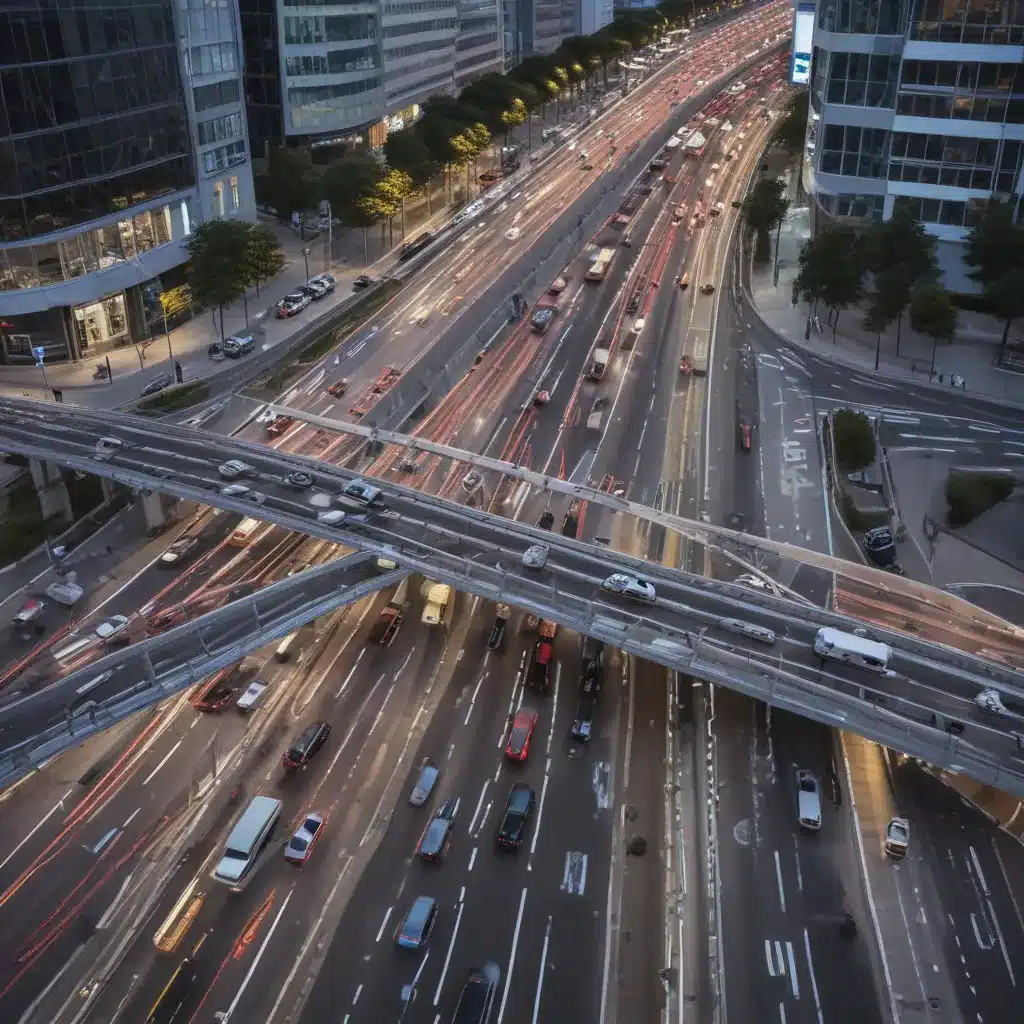The IoT Revolution in Transportation
Ah, the woes of urban traffic. As a city dweller, I’ve been there – sitting in gridlock, watching the minutes tick by, my frustration building. But what if I told you the solution to our traffic troubles lies in the magical world of the Internet of Things (IoT)? Prepare to have your mind blown, my friends.
It all started when I stumbled upon this amazing technology that’s quietly transforming the way we manage traffic. You see, IoT is bringing a whole new level of intelligence and automation to our roads, and the results are nothing short of remarkable. Imagine a world where traffic lights communicate with each other, adjusting their timing based on real-time data. Where sensors embedded in the streets can detect accidents and alert authorities instantly. Where drivers are guided to open parking spots, reducing the endless circle of the parking lot dance. [1]
This is the future we’re living in, and it’s all thanks to the powerful union of IoT, robotics, and AI. Let me take you on a journey through the cutting-edge advancements that are revolutionizing traffic management.
Connecting the Dots with IoT Sensors
Imagine a city where every traffic light, every intersection, and every street is equipped with a network of interconnected IoT sensors. These sensors don’t just passively observe the flow of traffic; they’re actively communicating, sharing data, and making decisions to optimize the flow of vehicles and pedestrians. [2]
Picture this – you’re driving down the road, and as you approach an intersection, the traffic lights ahead of you seamlessly adjust their timing, based on the real-time data collected by the sensors. No more sitting through endless red lights, no more wasted time and fuel. The system is constantly adapting, responding to changes in traffic patterns, weather conditions, and even accidents. [3]
And it’s not just about the traffic lights. These IoT sensors can also detect the presence of pedestrians, cyclists, and even emergency vehicles, adjusting the signals accordingly to ensure the safety of all road users. Imagine how much stress and danger we could eliminate from our daily commutes.
Predicting the Future with IoT Analytics
But the magic of IoT in traffic management doesn’t stop there. These sensors are also collecting a wealth of data, which is then fed into advanced analytics systems powered by AI and machine learning. [4] Suddenly, we have the ability to predict traffic patterns, identify areas of chronic congestion, and even anticipate the impact of events or weather conditions on the road network.
Envision a future where your GPS app not only guides you to your destination but also provides real-time updates on the optimal route, factoring in current traffic conditions and even offering suggestions to avoid potential bottlenecks before they even happen. [5] It’s like having a crystal ball for your daily commute!
And the benefits don’t just stop at the individual level. City planners and transportation authorities can use this wealth of data to make informed decisions about infrastructure investments, traffic signal optimization, and even the placement of new roads and public transit options. [6] It’s a game-changer for urban planning and the future of our cities.
Transforming the Driving Experience with IoT
But the IoT revolution in traffic management doesn’t just end with sensors and analytics. It’s also transforming the driving experience itself. Imagine a world where your car is seamlessly connected to the broader IoT network, communicating with traffic signals, other vehicles, and even pedestrian devices. [7]
This V2X (vehicle-to-everything) technology allows your car to anticipate traffic conditions, adjust its speed accordingly, and even navigate intersections more safely by coordinating with surrounding vehicles. Picture a scenario where your car automatically slows down as it approaches a red light, or where it alerts you to the presence of a pedestrian in the crosswalk before you even see them. [8]
And it’s not just about safety – this connectivity also opens up a world of convenience. Imagine your car guiding you directly to an available parking spot, eliminating the endless circling and frustration of the parking lot hunt. Or imagine your vehicle automatically alerting you to maintenance needs, scheduling appointments and even ordering parts on your behalf. [9]
The Future of Traffic Management is Bright
As I reflect on the incredible advancements in IoT-powered traffic management, I can’t help but feel a sense of excitement for the future. No longer are we doomed to the whims of outdated infrastructure and analog systems – we’re on the brink of a transportation revolution that will make our cities smarter, safer, and more efficient.
The intersection of IoT, robotics, and AI is truly a game-changer, and the possibilities are endless. From adaptive traffic signals to predictive analytics, from connected vehicles to automated parking – the future of traffic management is bright, and it’s all thanks to the power of the Internet of Things. [10]
So the next time you find yourself sitting in traffic, just remember – help is on the way. The IoT revolution is here, and it’s about to make our commutes a whole lot smoother.
References:
[1] Telnyx. “IoT Monitoring Traffic.” https://telnyx.com/resources/iot-monitoring-traffic
[2] IEEE. “Advancing Traffic Management with IoT.” https://ieeexplore.ieee.org/document/8975582
[3] Intetics. “Advanced Traffic Management: A Powerful Union of Robotics, IoT, and AI.” https://intetics.com/blog/advanced-traffic-management-a-powerful-union-of-robotics-iot-and-ai/
[4] The Refinery. “Advancements in Internet of Things.” https://the-refinery.io/blog/advancements-in-internet-of-things
[5] Journal of Big Data. “Internet of Things (IoT) is a revolutionary approach for future technology enhancement: a review.” https://journalofbigdata.springeropen.com/articles/10.1186/s40537-019-0268-2
[6] Digi. “IoT Solutions for Transportation.” https://www.digi.com/blog/post/iot-solutions-for-transportation
[7] Aviation Today. “HALO Sensor Advances IoT Concept for Wireless Cabin Air Quality Monitoring.” https://www.aviationtoday.com/2020/06/12/halo-sensor-advances-iot-concept-wireless-cabin-air-quality-monitoring/
[8] IEEE. “The Role of Internet of Things (IoT) in Smart Cities: Architecture, Applications and Challenges.” https://ieeexplore.ieee.org/document/9953660
[9] IEEE. “Advancing Traffic Management with IoT.” https://ieeexplore.ieee.org/document/8975582
[10] Telnyx. “IoT Monitoring Traffic.” https://telnyx.com/resources/iot-monitoring-traffic













